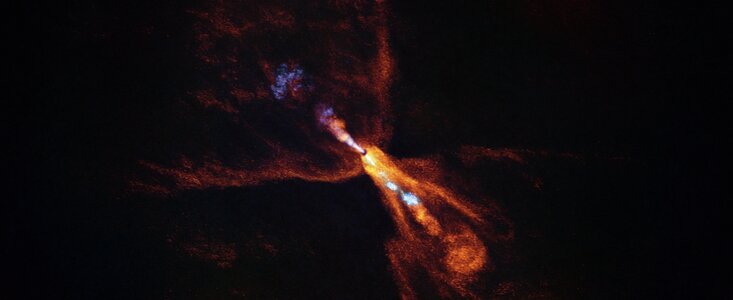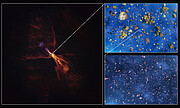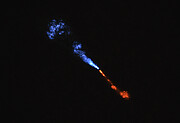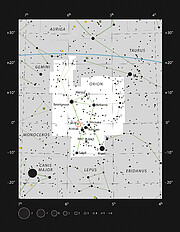Persbericht
Voor het eerst zijn astronomen getuige van de geboorte van een nieuw zonnestelsel
16 juli 2025

Een internationaal onderzoeksteam heeft voor het eerst het moment vastgesteld waarop zich planeten begonnen te vormen rond een andere ster dan onze zon. Met behulp van de ALMA-telescoop, waarin de Europese Zuidelijke Sterrenwacht (ESO) partner is, en de James Webb ruimtetelescoop (JWST), hebben ze het ontstaan van de eerste stukjes planeet-vormend materiaal waargenomen – hete mineralen die net beginnen te stollen. Het is voor het eerst dat een planetenstelsel in zo’n vroeg ontwikkelingsstadium is ontdekt. Zo krijgen we een kijkje in het verleden van ons eigen zonnestelsel.
‘Voor het eerst hebben we het vroegste moment geïdentificeerd waarop de planeetvorming rond een andere ster dan onze zon is begonnen’, zegt Melissa McClure, hoogleraar aan de Universiteit Leiden en hoofdauteur van het nieuwe onderzoek, waarvan de resultaten vandaag Nature zijn gepubliceerd.
Co-auteur Merel van ’t Hoff, hoogleraar aan de Purdue-universiteit in de Verenigde Staten, omschrijft het resultaat als ‘een babyfoto van ons zonnestelsel’ en zegt dat ‘we hier een stelsel zien dat lijkt op hoe ons zonnestelsel eruitzag toen het zich net begon te vormen.’
Dit pasgeboren planetenstelsel vormt zich rond HOPS-315, een ‘proto-’ oftewel babyster die zo’n 1300 lichtjaar van ons is verwijderd en sterke overeenkomsten vertoont met onze zon in haar jonge jaren. Rond zulke babysterren zijn vaak schijven van gas en stof te zien die ‘protoplanetaire schijven’ worden genoemd. Dit zijn de geboorteplaatsen van nieuwe planeten.
‘Astronomen hebben eerder al jonge schijven gezien met pasgeboren zware Jupiter-achtige planeten daarin’, zegt McClure. ‘Maar we hebben altijd geweten dat de eerste vaste delen van planeten – zogeheten ‘planetesimalen’ – zich in een eerder stadium moeten hebben gevormd.’
In ons eigen zonnestelsel is het allereerste vaste materiaal dat zich in de buurt van de huidige locatie ten opzichte van de zon heeft gevormd aangetroffen in stokoude meteorieten. Om te bepalen wanneer de klok is gaan lopen voor de vorming van ons zonnestelsel, hebben wetenschappers deze oergesteenten gedateerd. Zulke meteorieten zitten vol met kristalachtige mineralen die siliciummonoxide (SiO) bevatten en kunnen al bij de extreem hoge temperaturen in jonge planetaire schijven condenseren. Na verloop van tijd binden deze gecondenseerde vaste stoffen zich aan elkaar en leggen ze de kiem voor de vorming van planeten. De eerste planetesimalen in het zonnestelsel, die uitgroeiden tot planeten zoals de aarde of de kern van Jupiter, werden vlak na de condensatie van deze kristallijne mineralen gevormd.
Met hun nieuwe ontdekking hebben astronomen bewijs gevonden dat deze hete mineralen beginnen te condenseren in de schijf rond HOPS-315. Hun resultaten laten zien dat rond de babyster siliciummonoxide zowel in gasvormige als in kristallijne mineraalvorm aanwezig is, wat suggereert dat dit materiaal nog maar net begint te stollen. ‘Dit proces is nog nooit eerder gezien in een protoplanetaire schijf of elders buiten ons zonnestelsel’, zegt co-auteur Edwin Bergin, hoogleraar aan de Universiteit van Michigan, VS.
De mineralen werden voor het eerst geïdentificeerd met behulp van de James Webb Space Telescope, een gezamenlijk project van de ruimteagentschappen van de VS, Europa en Canada. Om erachter te komen waar de signalen precies vandaan kwamen, observeerde het team het stersysteem met de Atacama Large Millimeter/submillimeter Array (ALMA) in de Chileense Atacama-woestijn. ALMA wordt beheerd door ESO, in samenwerking met internationale partners.
Met de ALMA-gegevens stelde het team vast dat de chemische signalen afkomstig waren van een klein gebied in de schijf rond de ster waarvan de ligging overeenkomt met die van de planetoïdengordel rond de zon. ‘We zien de mineralen echt op dezelfde plek in dit stersysteem als waar we ze in de planetoïden van ons zonnestelsel zien,’ zegt co-auteur Logan Francis, postdoc-onderzoeker aan de Universiteit Leiden.
Hierdoor vormt de schijf van HOPS-315 een prachtige analogie voor het bestuderen van onze eigen kosmische geschiedenis. Of, zoals van ’t Hoff zegt: ‘Dit stersysteem is een van de beste die we kennen om een aantal van de processen te onderzoeken die in ons zonnestelsel hebben plaatsgevonden.’ Het systeem biedt astronomen ook een nieuwe kans om de vroege vorming van planeten te bestuderen, doordat het als surrogaat kan dienen voor pasgeboren zonnestelsels in elders in het Melkwegstelsel.
ESO-astronoom en Europees ALMA-programmamanager Elizabeth Humphreys, die niet aan het onderzoek heeft deelgenomen, zegt: ‘Ik was erg onder de indruk van dit onderzoek, dat een zeer vroeg stadium van planeetvorming laat zien. Het suggereert dat HOPS-315 kan worden gebruikt om te begrijpen hoe ons eigen zonnestelsel is gevormd. Dit resultaat onderstreept hoe waardevol de combinatie van JWST en ALMA is voor het onderzoek van protoplanetaire schijven.’
Meer informatie
De resultaten van dit onderzoek zijn te vinden in het artikel ‘Refractory solid condensation detected in an embedded protoplanetary disk’ (doi: 10.1038/s41586-025-09163-z) dat in Nature verschijnt.
Het onderzoeksteam bestaat uit M.K. McClure (Sterrewacht Leiden, Universiteit Leiden [Leiden]), M.’t Hoff (Department of Astronomy, The University of Michigan, Michigan, VS [Michigan] en Purdue University, Department of Physics and Astronomy, Indiana, VS), L. Francis (Leiden), Edwin Bergin (Michigan), W.R.M. Rocha (Leiden), J.A. Sturm (Leiden), D. Harsono (Instituut voor Astronomie, Departement Fysica, National Tsing Hua University, Taiwan), E.F. van Dishoeck (Leiden), J.H. Black (Chalmers University of Technology, Department of Space, Earth and Environment, Onsala Space Observatory, Zweden), J.A. Noble (Physique des Interactions Ioniques et Moléculaires, CNRS, Université d'Aix Marseille, Frankrijk), D. Qasim (Southwest Research Institute, Texas, VS), E. Dartois (Institut des Sciences Moléculaires d'Orsay, CNRS, Université Paris-Saclay, Frankrijk).
De Atacama Large Millimeter/submillimeter Array (ALMA), een internationale astronomische faciliteit, is een samenwerkingsverband van ESO, de Amerikaanse National Science Foundation (NSF) en de National Institutes of Natural Sciences (NINS) van Japan, in samenwerking met de Republiek Chili. ALMA wordt gefinancierd door ESO (namens haar lidstaten), door de NSF in samenwerking met de National Research Council of Canada (NRC) en de National Science and Technology Council (NSTC) in Taiwan, en door NINS in samenwerking met de Academia Sinica (AS) in Taiwan en het Korea Astronomy and Space Science Institute (KASI). De bouw en het beheer van ALMA worden geleid door ESO (namens haar lidstaten); door het National Radio Astronomy Observatory (NRAO), dat namens Noord-Amerika wordt bestuurd door de Associated Universities, Inc. (AUI), en namens Oost-Azië door het National Astronomical Observatory of Japan (NAOJ). De overkoepelende leiding en het toezicht op bouw, ingebruikname en beheer van ALMA is in handen van het Joint ALMA Observatory (JAO).
Links
• Voor journalisten: abonneer je op onze persberichten onder embargo in je eigen taal
• Voor wetenschappers: heb je een verhaal? Promoot je eigen onderzoek
• Nieuwe ESO-analyse bevestigt: ernstige schade door gepland industrieel complex bij Paranal
Contact
Melissa McClure
Leiden Observatory, Leiden University
Leiden, The Netherlands
Mobiel: on request
E-mail: mcclure@strw.leidenuniv.nl
Merel van ‘t Hoff
Department of Physics and Astronomy, Purdue University
West Lafayette, Indiana, United States
Tel: +1-734-882-0270
E-mail: vanthoff@purdue.edu
Logan Francis
Leiden Observatory, Leiden University
Leiden, The Netherlands
Tel: +31 71 527 2727
E-mail: francis@strw.leidenuniv.nl
Edwin Bergin
Department of Astronomy, University of Michigan
Ann Arbor, Michigan, United States
Tel: +1 734 764 3441
E-mail: ebergin@umich.edu
Elizabeth Humphreys
European Southern Observatory
Garching bei München, Germany
Tel: +49 89 3200 6541
E-mail: ehumphre@eso.org
Bárbara Ferreira
ESO Media Manager
Garching bei München, Germany
Tel: +49 89 3200 6670
Mobiel: +49 151 241 664 00
E-mail: press@eso.org
Marieke Baan (Perscontact Nederland)
ESO Science Outreach Network
en NOVA Informatie Centrum
Tel: +31(0)20-5257480
E-mail: eson-netherlands@eso.org
Over dit bericht
| Persberichten nr.: | eso2512nl |
| Type: | Milky Way : Star : Circumstellar Material : Disk : Protoplanetary |
| Facility: | Atacama Large Millimeter/submillimeter Array |
| Science data: | 2025Natur.643..649M |
Our use of Cookies
We use cookies that are essential for accessing our websites and using our services. We also use cookies to analyse, measure and improve our websites’ performance, to enable content sharing via social media and to display media content hosted on third-party platforms.
ESO Cookies Policy
The European Organisation for Astronomical Research in the Southern Hemisphere (ESO) is the pre-eminent intergovernmental science and technology organisation in astronomy. It carries out an ambitious programme focused on the design, construction and operation of powerful ground-based observing facilities for astronomy.
This Cookies Policy is intended to provide clarity by outlining the cookies used on the ESO public websites, their functions, the options you have for controlling them, and the ways you can contact us for additional details.
What are cookies?
Cookies are small pieces of data stored on your device by websites you visit. They serve various purposes, such as remembering login credentials and preferences and enhance your browsing experience.
Categories of cookies we use
Essential cookies (always active): These cookies are strictly necessary for the proper functioning of our website. Without these cookies, the website cannot operate correctly, and certain services, such as logging in or accessing secure areas, may not be available; because they are essential for the website’s operation, they cannot be disabled.
Functional Cookies: These cookies enhance your browsing experience by enabling additional features and personalization, such as remembering your preferences and settings. While not strictly necessary for the website to function, they improve usability and convenience; these cookies are only placed if you provide your consent.
Analytics cookies: These cookies collect information about how visitors interact with our website, such as which pages are visited most often and how users navigate the site. This data helps us improve website performance, optimize content, and enhance the user experience; these cookies are only placed if you provide your consent. We use the following analytics cookies.
Matomo Cookies:
This website uses Matomo (formerly Piwik), an open source software which enables the statistical analysis of website visits. Matomo uses cookies (text files) which are saved on your computer and which allow us to analyze how you use our website. The website user information generated by the cookies will only be saved on the servers of our IT Department. We use this information to analyze www.eso.org visits and to prepare reports on website activities. These data will not be disclosed to third parties.
On behalf of ESO, Matomo will use this information for the purpose of evaluating your use of the website, compiling reports on website activity and providing other services relating to website activity and internet usage.
Matomo cookies settings:
Additional Third-party cookies on ESO websites: some of our pages display content from external providers, e.g. YouTube.
Such third-party services are outside of ESO control and may, at any time, change their terms of service, use of cookies, etc.
YouTube: Some videos on the ESO website are embedded from ESO’s official YouTube channel. We have enabled YouTube’s privacy-enhanced mode, meaning that no cookies are set unless the user actively clicks on the video to play it. Additionally, in this mode, YouTube does not store any personally identifiable cookie data for embedded video playbacks. For more details, please refer to YouTube’s embedding videos information page.
Cookies can also be classified based on the following elements.
Regarding the domain, there are:
- First-party cookies, set by the website you are currently visiting. They are stored by the same domain that you are browsing and are used to enhance your experience on that site;
- Third-party cookies, set by a domain other than the one you are currently visiting.
As for their duration, cookies can be:
- Browser-session cookies, which are deleted when the user closes the browser;
- Stored cookies, which stay on the user's device for a predetermined period of time.
How to manage cookies
Cookie settings: You can modify your cookie choices for the ESO webpages at any time by clicking on the link Cookie settings at the bottom of any page.
In your browser: If you wish to delete cookies or instruct your browser to delete or block cookies by default, please visit the help pages of your browser:
Please be aware that if you delete or decline cookies, certain functionalities of our website may be not be available and your browsing experience may be affected.
You can set most browsers to prevent any cookies being placed on your device, but you may then have to manually adjust some preferences every time you visit a site/page. And some services and functionalities may not work properly at all (e.g. profile logging-in, shop check out).
Updates to the ESO Cookies Policy
The ESO Cookies Policy may be subject to future updates, which will be made available on this page.
Additional information
For any queries related to cookies, please contact: pdprATesoDOTorg.
As ESO public webpages are managed by our Department of Communication, your questions will be dealt with the support of the said Department.







